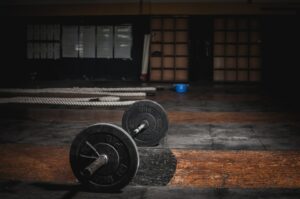The Data Is Surprisingly Clear

I have a reputation as a “TryHard” and my training frequency is fairly high. The first thing I did that garnered any significant attention was my MMA Training Schedule (Barbell Complexes, Resistant aerobics with a mix of strength & speed training) It garnered fantastic MEASURABLE results but was generally utilized by competitors only.
There is a lot of misinformation going around about how competitors / fighters / athletes should train. Currently it seems that some coaches of notoriety who only train elite level athletes claim to use only plyometrics and bodyweight training. That only works if the athlete already possess a formidable strength base, But why does that matter? If I wanted to train a non strength trained tennis player to get from one side of the court to the other faster, do I give them a heavier racket or do I train their legs to develop more force production via heavy squats & lunges. The best way to increase an amateur athletes speed, power, movement, knock out potential is by first increasing their ability to produce force.
How strong should you be?
These are the baseline numbers I use with my athletes. Body type will determine what lifts the athlete is really good at and what ones they will struggle with. For women, the goal of meeting the intermediate mark puts them into the top category. For men the charts are as follows.
| 1RM Strength Test | |
| Deadlift | Bench |
| Advanced 2x Bodyweight | Advanced 1.25 Bodyweight |
| Intermediate 1.8x Bodyweight | Intermediate 1.1 Bodyweight |
| Beginner 1.5x Bodyweight | Beginner .75 Bodyweight |
| 5RM Strength Test | ||
| Back Squat | Deadlift | OH Press |
| Advanced 1x bodyweight | Advanced 1.5x bodyweight | Advanced .67x bodyweight |
| Intermediate .9x bodyweight | Intermediate 1.3x bodyweight | Intermediate .5x bodyweight |
| Beginner .75 bodyweight | Beginner .85 bodyweight | Beginner .4x bodyweight |
Getting There Fast
My typical clients’ training frequencies are pretty normal, slightly high side of average. In 2012, the “Norwegian Frequency Project” came out, the findings were that training each lift six times per week led to faster strength gains than training each lift three times per week. And that’s excellent but few fighters & athletes can afford to weight train that often. So I kept reading… study – after study – after study – after study and then some.
They all have something in common – showing higher training frequencies lead to faster strength gains. Especially for upper body pressing exercises. Higher frequencies seem to lead to 20+% faster strength gains, in both trained and untrained athletes, and there seems to be a fairly linear increase in the benefits of increased frequency, with 1<2<3<4+. Interestingly footnote – frequency does not significantly affect lower body strength gains, while it does significantly affect upper body strength gains!
Recommendations for Training Frequency
Plenty of people have gotten very, VERY strong with low training frequencies, tho it might of taken a bit longer. If you can’t find the time to bench press three or more times per week your progress won’t stop, higher pressing frequencies are just more optimal. On the flip side, if you find that you respond really well to squatting four times per week, don’t dial back the frequency because the study’s found that frequency didn’t matter as much for lower body exercises.
Takeaway
Higher frequencies of 4+ per week have been shown to lead to faster strength gains for upper body pressing exercises & strength gains for squat-type movements seem to be less affected by frequency.
If you decide to increase your training frequency for a particular lift, I recommend lowering your session volume to equate to your current weekly volume. Once you dial in your recovery between sessions, you can start ramping up your session volume.
Looking to increase your strength & take the guess work out of your training? Click Here
Written By – Derek Frohlich

